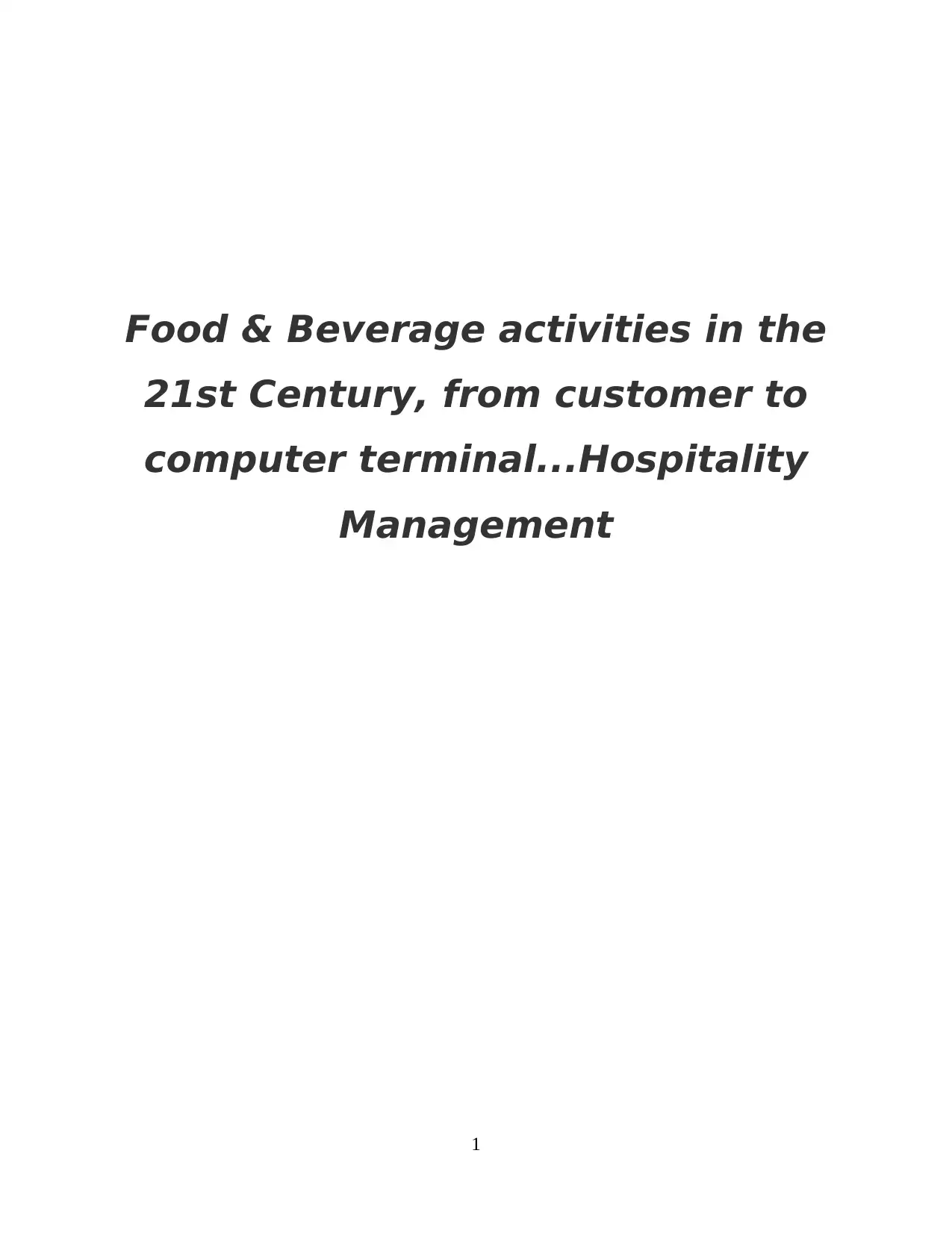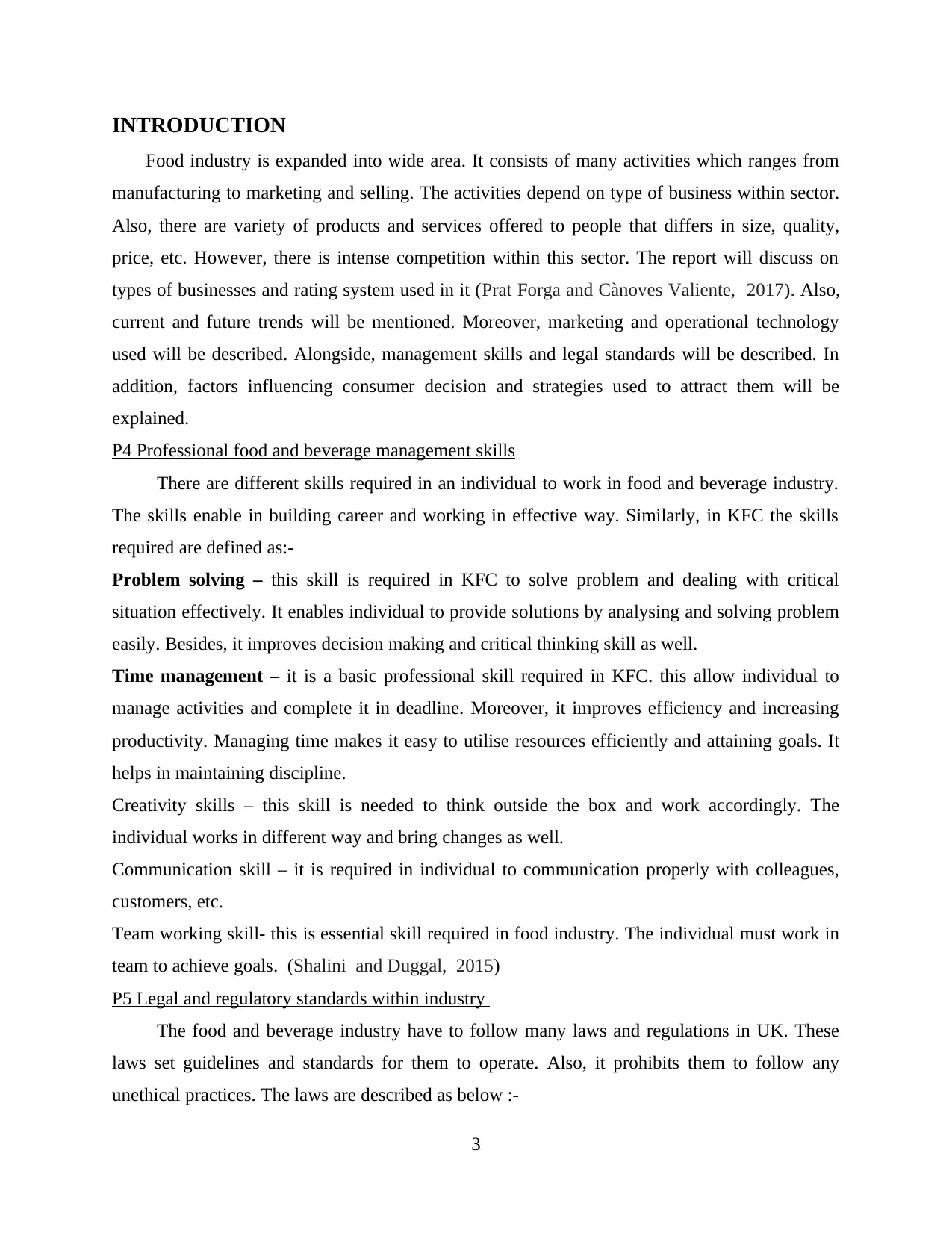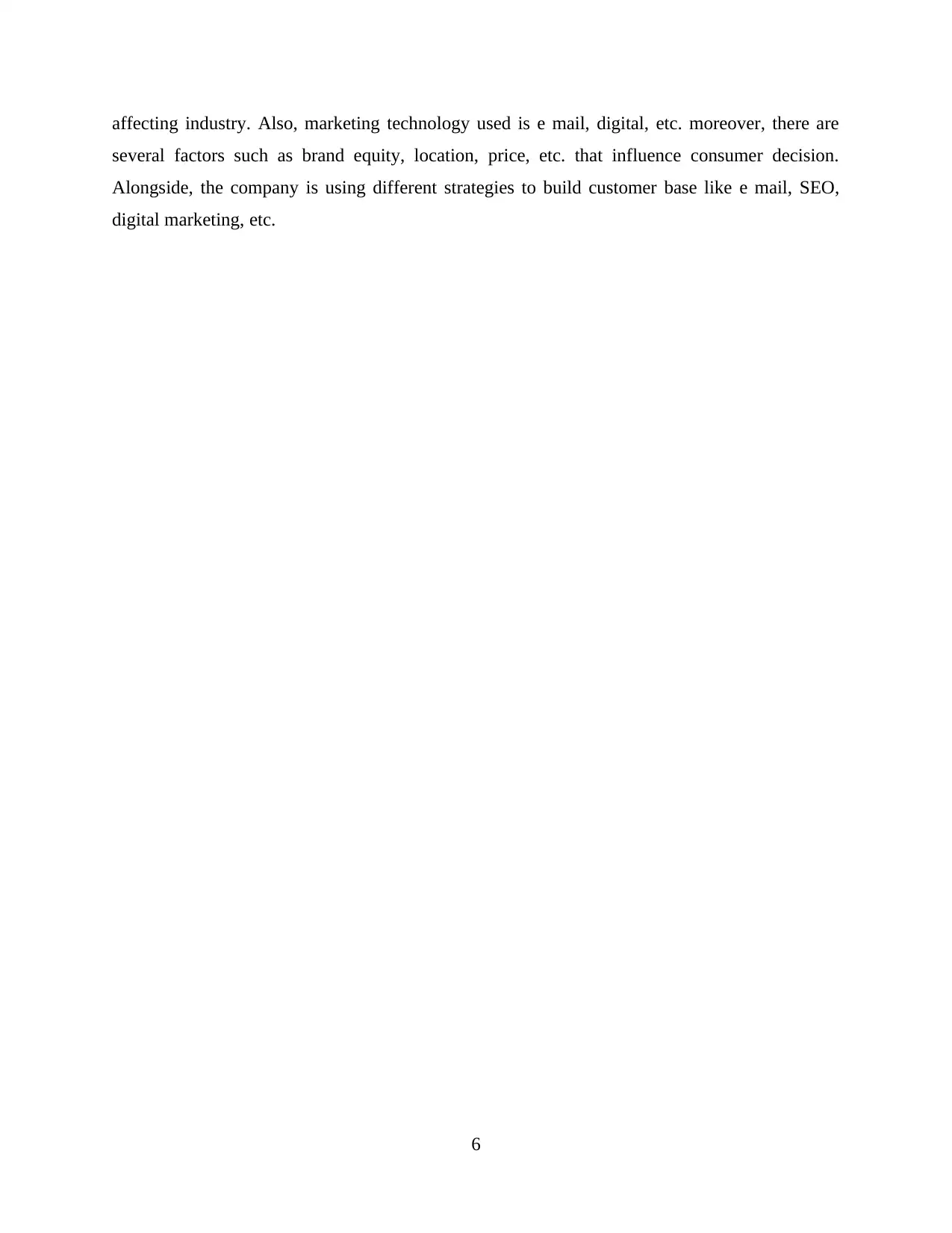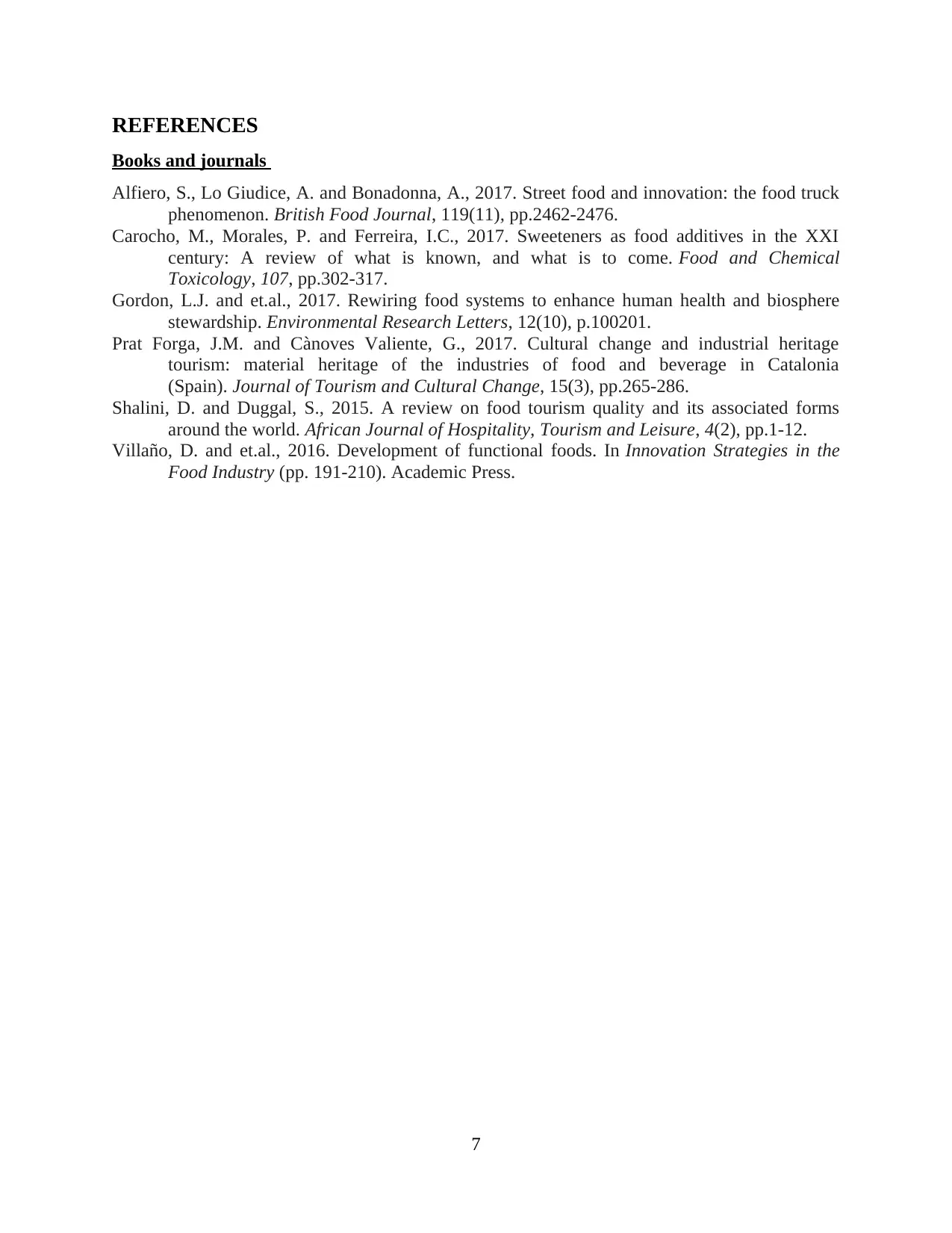Food & Beverage Activities in the 21st Century, Hospitality Report
VerifiedAdded on 2023/01/17
|7
|1732
|33
Report
AI Summary
This report provides an overview of the food and beverage industry, exploring various aspects from management skills and legal standards to consumer decision-making and marketing strategies. It begins with an introduction to the industry, encompassing different business types, rating systems, and current and future trends. The report then delves into the professional skills required in the food and beverage sector, using KFC as a case study, and outlines relevant legal and regulatory standards in the UK. It examines factors influencing consumer decisions, such as brand equity, affordability, menu variety, and location. Furthermore, the report discusses strategies for building a customer base, including special offers, email marketing, SEO, digital marketing, and neighborhood company strategies. The conclusion summarizes the key findings, highlighting the diverse businesses, grading systems, trends, marketing technologies, consumer influences, and customer base strategies within the dynamic food and beverage industry. The report utilizes academic sources to support its claims.

Food & Beverage activities in the
21st Century, from customer to
computer terminal...Hospitality
Management
1
21st Century, from customer to
computer terminal...Hospitality
Management
1
Paraphrase This Document
Need a fresh take? Get an instant paraphrase of this document with our AI Paraphraser

Table of Contents
INTRODUCTION...........................................................................................................................3
P4 Professional food and beverage management skills...............................................................3
P5 Legal and regulatory standards within industry.....................................................................3
P7 Factors influence consumer decision making.........................................................................4
P8 Strategies used to build customer base...................................................................................5
CONCLUSION................................................................................................................................5
REFERENCES................................................................................................................................7
2
INTRODUCTION...........................................................................................................................3
P4 Professional food and beverage management skills...............................................................3
P5 Legal and regulatory standards within industry.....................................................................3
P7 Factors influence consumer decision making.........................................................................4
P8 Strategies used to build customer base...................................................................................5
CONCLUSION................................................................................................................................5
REFERENCES................................................................................................................................7
2

INTRODUCTION
Food industry is expanded into wide area. It consists of many activities which ranges from
manufacturing to marketing and selling. The activities depend on type of business within sector.
Also, there are variety of products and services offered to people that differs in size, quality,
price, etc. However, there is intense competition within this sector. The report will discuss on
types of businesses and rating system used in it (Prat Forga and Cànoves Valiente, 2017). Also,
current and future trends will be mentioned. Moreover, marketing and operational technology
used will be described. Alongside, management skills and legal standards will be described. In
addition, factors influencing consumer decision and strategies used to attract them will be
explained.
P4 Professional food and beverage management skills
There are different skills required in an individual to work in food and beverage industry.
The skills enable in building career and working in effective way. Similarly, in KFC the skills
required are defined as:-
Problem solving – this skill is required in KFC to solve problem and dealing with critical
situation effectively. It enables individual to provide solutions by analysing and solving problem
easily. Besides, it improves decision making and critical thinking skill as well.
Time management – it is a basic professional skill required in KFC. this allow individual to
manage activities and complete it in deadline. Moreover, it improves efficiency and increasing
productivity. Managing time makes it easy to utilise resources efficiently and attaining goals. It
helps in maintaining discipline.
Creativity skills – this skill is needed to think outside the box and work accordingly. The
individual works in different way and bring changes as well.
Communication skill – it is required in individual to communication properly with colleagues,
customers, etc.
Team working skill- this is essential skill required in food industry. The individual must work in
team to achieve goals. (Shalini and Duggal, 2015)
P5 Legal and regulatory standards within industry
The food and beverage industry have to follow many laws and regulations in UK. These
laws set guidelines and standards for them to operate. Also, it prohibits them to follow any
unethical practices. The laws are described as below :-
3
Food industry is expanded into wide area. It consists of many activities which ranges from
manufacturing to marketing and selling. The activities depend on type of business within sector.
Also, there are variety of products and services offered to people that differs in size, quality,
price, etc. However, there is intense competition within this sector. The report will discuss on
types of businesses and rating system used in it (Prat Forga and Cànoves Valiente, 2017). Also,
current and future trends will be mentioned. Moreover, marketing and operational technology
used will be described. Alongside, management skills and legal standards will be described. In
addition, factors influencing consumer decision and strategies used to attract them will be
explained.
P4 Professional food and beverage management skills
There are different skills required in an individual to work in food and beverage industry.
The skills enable in building career and working in effective way. Similarly, in KFC the skills
required are defined as:-
Problem solving – this skill is required in KFC to solve problem and dealing with critical
situation effectively. It enables individual to provide solutions by analysing and solving problem
easily. Besides, it improves decision making and critical thinking skill as well.
Time management – it is a basic professional skill required in KFC. this allow individual to
manage activities and complete it in deadline. Moreover, it improves efficiency and increasing
productivity. Managing time makes it easy to utilise resources efficiently and attaining goals. It
helps in maintaining discipline.
Creativity skills – this skill is needed to think outside the box and work accordingly. The
individual works in different way and bring changes as well.
Communication skill – it is required in individual to communication properly with colleagues,
customers, etc.
Team working skill- this is essential skill required in food industry. The individual must work in
team to achieve goals. (Shalini and Duggal, 2015)
P5 Legal and regulatory standards within industry
The food and beverage industry have to follow many laws and regulations in UK. These
laws set guidelines and standards for them to operate. Also, it prohibits them to follow any
unethical practices. The laws are described as below :-
3
⊘ This is a preview!⊘
Do you want full access?
Subscribe today to unlock all pages.

Trusted by 1+ million students worldwide

Food standard act 1999- this law protects public health in relation to food. Here, outlet have to
act in consumer interest by providing them power to perform function according to food and
safety standards. (Alfiero, Lo Giudice, and Bonadonna, 2017)
Food safety act 1990- it is related to health and safety of people. the businesses have to ensure
that they do not provide food that can harm individual health. Besides, they have to serve high
quality food. Moreover, the labelling and adverting of food must not be misled.
General food law – This la is set by EU that lays foundation of principles, procedure in matters
of food safety. Here, at both union and national level its principles are followed.
Food information regulation – it sets out certain standards and provision that are to be followed
by companies. furthermore, it states punishment in failure to comply with regulations. In
addition, permission by FIC is included as :-
To provide info about milk products in glass bottles.
Update food labelling as per food information regulation 2014.
Retain requirement of meat content for meat products.
P7 Factors influence consumer decision making
A consumer takes a decision on several basis like need, cost, quality of product, etc. By
evaluating all this decision is taken. But there are some factors that influence their decision. They
are as described below :- (Villaño and et.al., 2016)
Brand equity – It is major factor that influence consumer decision. This is because brand equity
represent value delivered by products and services. So, a strong brand equity will distract mind
set of customers towards it. On other side, low brand equity is not preferred. However, it also
helps in competing with rivals in the market and gaining people trust. So, the first thing that
customer evaluate is brand equity. Any impact on this influence customer decision.
Affordability- This is second facto that is considered here. Customer will analyse cost of any
product or service before buying it. So, if a product is not affordable then it becomes difficult for
them to buy it. But any change in price highly influence consumer decision to buy it. They
consume that goods in more quantity. hence, fair price enables in attracting more people.
Menu variety- It refers to number of products and services available in outlet. By offering more
range of food and beverage it is easy to attract people. Alongside, customer prefer those outlets
that contains variety of dishes. Therefore, change in menu items will directly affect customer
decision. Change in menu items will force them to prefer another outlet.
4
act in consumer interest by providing them power to perform function according to food and
safety standards. (Alfiero, Lo Giudice, and Bonadonna, 2017)
Food safety act 1990- it is related to health and safety of people. the businesses have to ensure
that they do not provide food that can harm individual health. Besides, they have to serve high
quality food. Moreover, the labelling and adverting of food must not be misled.
General food law – This la is set by EU that lays foundation of principles, procedure in matters
of food safety. Here, at both union and national level its principles are followed.
Food information regulation – it sets out certain standards and provision that are to be followed
by companies. furthermore, it states punishment in failure to comply with regulations. In
addition, permission by FIC is included as :-
To provide info about milk products in glass bottles.
Update food labelling as per food information regulation 2014.
Retain requirement of meat content for meat products.
P7 Factors influence consumer decision making
A consumer takes a decision on several basis like need, cost, quality of product, etc. By
evaluating all this decision is taken. But there are some factors that influence their decision. They
are as described below :- (Villaño and et.al., 2016)
Brand equity – It is major factor that influence consumer decision. This is because brand equity
represent value delivered by products and services. So, a strong brand equity will distract mind
set of customers towards it. On other side, low brand equity is not preferred. However, it also
helps in competing with rivals in the market and gaining people trust. So, the first thing that
customer evaluate is brand equity. Any impact on this influence customer decision.
Affordability- This is second facto that is considered here. Customer will analyse cost of any
product or service before buying it. So, if a product is not affordable then it becomes difficult for
them to buy it. But any change in price highly influence consumer decision to buy it. They
consume that goods in more quantity. hence, fair price enables in attracting more people.
Menu variety- It refers to number of products and services available in outlet. By offering more
range of food and beverage it is easy to attract people. Alongside, customer prefer those outlets
that contains variety of dishes. Therefore, change in menu items will directly affect customer
decision. Change in menu items will force them to prefer another outlet.
4
Paraphrase This Document
Need a fresh take? Get an instant paraphrase of this document with our AI Paraphraser

Location – It is also a factor as customer prefer to visit nearest outlets. The restaurant is to be
located in their region. In this location is to be safe, secure, etc. the view provided must be good.
Thus, change in location directly influence customer decision to visit outlet (Gordon and et.al.,
2017).
P8 Strategies used to build customer base
In food and beverage industry it is necessary for companies to build a strong customer
base. It allows them to sustain for long term. Furthermore, they are able to attract large number
of people. The strategies have to be developed as per target market. They are discussed below:
Special offers- It is a strategy used by outlet to attract people. In this they provide coupons,
discount, loyalty points, etc. to people. However, by offering offers on festivals and other
occasions, outlet built customer base. For example- KFC offer 10% discount to first time
customers and they have also started happy hours concept.
E mail marketing – this is another strategy used to build customer base. Here, outlet promote
goods by sending e mail to people. Additionally, new products and services info is also mailed.
So, this generate awareness among them. KFC uses this strategy to retain customers. They
provide offer and discounts to them.
SEO – company uses SEO to generate traffic on their website. Here, certain key words are used
to increase users search on website. However, results are analysed to identify traffic rate.
Applying an effective SEO helps the companies to display their page on the top of google and
increase traffic on website. (Carocho, Morales and Ferreira, 2017)
Digital marketing - KFC uses digital marketing in order to attract customers. through this, they
do marketing on various platforms such as social media, website, etc. On that ads are placed
about products and services to attract people.
Neighborhood companies- Now a days, this is the most frequently used strategy used by the
restaurants and food chains to attract the new customers. Owners mostly visit the company’s
nearby their restaurant and establishment and stimulate the customer's interest through personal
contact with them.
CONCLUSION
From report it is concluded that there are many businesses in food industry like hotel,
restaurant, catering, etc. they all offer different services and products. There are various grading
system uses like Dozen rating, Health star system, GNPD system. Current and future trends are
5
located in their region. In this location is to be safe, secure, etc. the view provided must be good.
Thus, change in location directly influence customer decision to visit outlet (Gordon and et.al.,
2017).
P8 Strategies used to build customer base
In food and beverage industry it is necessary for companies to build a strong customer
base. It allows them to sustain for long term. Furthermore, they are able to attract large number
of people. The strategies have to be developed as per target market. They are discussed below:
Special offers- It is a strategy used by outlet to attract people. In this they provide coupons,
discount, loyalty points, etc. to people. However, by offering offers on festivals and other
occasions, outlet built customer base. For example- KFC offer 10% discount to first time
customers and they have also started happy hours concept.
E mail marketing – this is another strategy used to build customer base. Here, outlet promote
goods by sending e mail to people. Additionally, new products and services info is also mailed.
So, this generate awareness among them. KFC uses this strategy to retain customers. They
provide offer and discounts to them.
SEO – company uses SEO to generate traffic on their website. Here, certain key words are used
to increase users search on website. However, results are analysed to identify traffic rate.
Applying an effective SEO helps the companies to display their page on the top of google and
increase traffic on website. (Carocho, Morales and Ferreira, 2017)
Digital marketing - KFC uses digital marketing in order to attract customers. through this, they
do marketing on various platforms such as social media, website, etc. On that ads are placed
about products and services to attract people.
Neighborhood companies- Now a days, this is the most frequently used strategy used by the
restaurants and food chains to attract the new customers. Owners mostly visit the company’s
nearby their restaurant and establishment and stimulate the customer's interest through personal
contact with them.
CONCLUSION
From report it is concluded that there are many businesses in food industry like hotel,
restaurant, catering, etc. they all offer different services and products. There are various grading
system uses like Dozen rating, Health star system, GNPD system. Current and future trends are
5

affecting industry. Also, marketing technology used is e mail, digital, etc. moreover, there are
several factors such as brand equity, location, price, etc. that influence consumer decision.
Alongside, the company is using different strategies to build customer base like e mail, SEO,
digital marketing, etc.
6
several factors such as brand equity, location, price, etc. that influence consumer decision.
Alongside, the company is using different strategies to build customer base like e mail, SEO,
digital marketing, etc.
6
⊘ This is a preview!⊘
Do you want full access?
Subscribe today to unlock all pages.

Trusted by 1+ million students worldwide

REFERENCES
Books and journals
Alfiero, S., Lo Giudice, A. and Bonadonna, A., 2017. Street food and innovation: the food truck
phenomenon. British Food Journal, 119(11), pp.2462-2476.
Carocho, M., Morales, P. and Ferreira, I.C., 2017. Sweeteners as food additives in the XXI
century: A review of what is known, and what is to come. Food and Chemical
Toxicology, 107, pp.302-317.
Gordon, L.J. and et.al., 2017. Rewiring food systems to enhance human health and biosphere
stewardship. Environmental Research Letters, 12(10), p.100201.
Prat Forga, J.M. and Cànoves Valiente, G., 2017. Cultural change and industrial heritage
tourism: material heritage of the industries of food and beverage in Catalonia
(Spain). Journal of Tourism and Cultural Change, 15(3), pp.265-286.
Shalini, D. and Duggal, S., 2015. A review on food tourism quality and its associated forms
around the world. African Journal of Hospitality, Tourism and Leisure, 4(2), pp.1-12.
Villaño, D. and et.al., 2016. Development of functional foods. In Innovation Strategies in the
Food Industry (pp. 191-210). Academic Press.
7
Books and journals
Alfiero, S., Lo Giudice, A. and Bonadonna, A., 2017. Street food and innovation: the food truck
phenomenon. British Food Journal, 119(11), pp.2462-2476.
Carocho, M., Morales, P. and Ferreira, I.C., 2017. Sweeteners as food additives in the XXI
century: A review of what is known, and what is to come. Food and Chemical
Toxicology, 107, pp.302-317.
Gordon, L.J. and et.al., 2017. Rewiring food systems to enhance human health and biosphere
stewardship. Environmental Research Letters, 12(10), p.100201.
Prat Forga, J.M. and Cànoves Valiente, G., 2017. Cultural change and industrial heritage
tourism: material heritage of the industries of food and beverage in Catalonia
(Spain). Journal of Tourism and Cultural Change, 15(3), pp.265-286.
Shalini, D. and Duggal, S., 2015. A review on food tourism quality and its associated forms
around the world. African Journal of Hospitality, Tourism and Leisure, 4(2), pp.1-12.
Villaño, D. and et.al., 2016. Development of functional foods. In Innovation Strategies in the
Food Industry (pp. 191-210). Academic Press.
7
1 out of 7
Related Documents
Your All-in-One AI-Powered Toolkit for Academic Success.
+13062052269
info@desklib.com
Available 24*7 on WhatsApp / Email
![[object Object]](/_next/static/media/star-bottom.7253800d.svg)
Unlock your academic potential
Copyright © 2020–2025 A2Z Services. All Rights Reserved. Developed and managed by ZUCOL.



